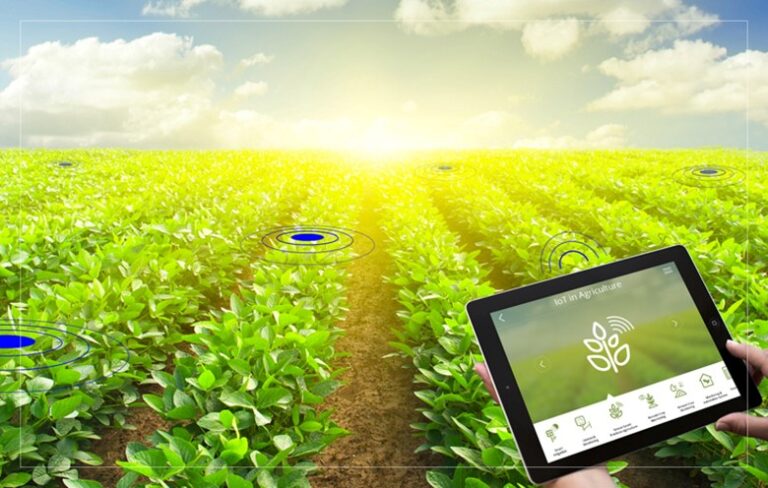Smart Technology-Driven Agriculture
Smart Technology-driven Agriculture solutions for a country
AI and smart technology indeed have immense potential to transform the agricultural sector in a country, addressing challenges and enhancing development in several key areas:
- Enhanced Crop Yields through Precision Farming: By integrating AI-driven precision farming techniques, farmers in a country can significantly improve crop yields. AI can analyze data on soil conditions, weather patterns, and crop health to provide farmers with precise recommendations on planting, irrigation, and harvesting times. This approach can lead to more efficient use of resources and higher productivity.
- Resource Optimization: AI technologies can optimize the use of resources like water, fertilizers, and pesticides. Smart irrigation systems, for instance, can use weather forecasts and soil moisture sensors to water crops only when necessary, reducing water consumption and costs.
- Market Connectivity: AI can connect farmers to markets more effectively. By analyzing market trends and prices, AI can help farmers understand the best times to sell their produce, ensuring better profits. Digital platforms can be instrumental in this regard, connecting over hundreds of thousands farmers across the country.
- Addressing Food Security: With improved yields and efficient farming practices, AI in agriculture can significantly contribute to a country’s food security. Better crop management and resource utilization can ensure a more stable and abundant food supply.
- Managing Risks and Ethical Considerations: As AI becomes more prevalent in agriculture, it’s important to manage risks and ethical considerations, such as the impact on employment and ensuring equitable access to technology for all farmers.
- Climate Change Adaptation: AI can help in adapting farming practices to the challenges posed by climate change. By predicting weather patterns and identifying areas at risk of drought or flooding, AI can guide farmers in taking pre-emptive measures to protect their crops.
The adoption of AI and smart technology in agriculture could be a game-changer for a country, improving agricultural efficiency, enhancing food security, and potentially boosting the country’s economy.
Precision Agriculture solutions
State-of-the-art precision agriculture (PA) is an advanced approach to farming that utilizes modern technologies for site-specific management of crop fields. It involves the use of various technologies, tools, and practices to optimize both the efficiency and productivity of farming operations while minimizing environmental impacts. Key components of state-of-the-art PA include:
- Global Navigation Satellite Systems (GNSS): Used for precise field mapping, navigation, and for conducting soil sampling. GNSS enables accurate positioning which is fundamental for many PA practices.
- Information and Communication Technologies: These include sensors, drones, and IoT devices that collect and transmit data about crop conditions, soil quality, and weather patterns, assisting in making informed decisions about planting, harvesting, and managing resources.
- Remote Sensing Techniques: Utilizing satellite imagery or aerial photos taken from drones to monitor crop health, identify pest infestations, and manage water usage more efficiently.
- Data Management and Analysis: Advanced software systems analyze the collected data to provide insights and recommendations for optimal farm management strategies.
HumiSoil:
HumiSoil is a product designed to enhance soil health by improving its structure, nutrient content, and microbial activity. In a context like a country, where agriculture plays a crucial role in the economy and food security, HumiSoil could be particularly beneficial:
- Soil Fertility Improvement: HumiSoil can contribute to improving the fertility of the soil in a country, particularly in areas where the soil may be degraded or lacking in essential nutrients.
- Enhanced Crop Yields: By improving soil health, HumiSoil can help in increasing crop yields, which is critical in a region that faces food security challenges.
- Sustainable Farming Practices: The use of HumiSoil can promote sustainable farming practices, reducing the need for chemical fertilizers, and helping in the conservation of natural resources.
- Adaptation to Climate Variability: Improving soil health can also make crops more resilient to climate variability, which is a significant concern in a country.
For a comprehensive assessment of how HumiSoil could specifically benefit a country, it would be essential to consider local soil conditions, climate, and the specific needs of the agricultural sector in the region.
To implement smart technology-driven agriculture solutions in a country, a combination of hardware and software solutions, along with strategic deliverables, is needed:
- Global Navigation Satellite Systems (GNSS): Essential for precise field mapping and soil sampling, GNSS technologies enable accurate positioning for various precision farming activities.
- Information and Communication Technologies: Incorporate sensors, drones, and IoT devices for data collection on crop conditions, soil quality, and weather patterns. This data aids in making informed decisions about agriculture.
- Remote Sensing Techniques: Use satellite imagery and drones for monitoring crop health and managing water usage, which is crucial for efficient and sustainable farming practices.
- Data Management Software: Advanced software systems for analyzing the data collected from GNSS, sensors, and remote sensing. These systems provide insights and recommendations for optimal farm management.
- AI-Driven Analytics: Implement AI algorithms for analyzing soil conditions, weather patterns, and crop health to provide precise recommendations for planting, irrigation, and harvesting.
- Smart Irrigation Systems: Utilize AI technologies to optimize water usage. Systems that can analyze soil moisture and weather forecasts will ensure efficient water usage, conserving this crucial resource.
- Market Connectivity Platforms: Digital platforms to connect farmers directly with markets, analyzing market trends and prices to help farmers understand the best times to sell their produce.
- Training and Capacity Building: Provide training for local farmers and agricultural workers on how to use these technologies effectively.
- HumiSoil Integration: Consider using products like HumiSoil to improve soil health, which in turn can enhance crop yields and promote sustainable farming practices.
- Climate Change Adaptation Tools: Develop tools and strategies using AI and smart technology to adapt farming practices to the challenges posed by climate change.
By implementing these solutions, a country can significantly enhance its agricultural efficiency, boost food security, and adapt to climate variability, contributing positively to the economy and livelihoods of its people.


